The Inner Nature of Music and the Experience of Tone
GA 283

“A tone lies at the foundation of
everything in the physical world.”This is only one of many unexpected statements made by Rudolf Steiner in these unusual spiritual scientific studies of the art of music. In seven lectures delivered in Europe between 1906 and 1923, Steiner penetrates with esoteric insight into the realities hidden behind the experience of music.
Music has always occupied a special place among the arts, as recognized by the philosopher, Schopenhauer. Its source, explains Steiner, lies not in the physical world but purely in the invisible spiritual world, the true home of the human soul. The musician thus stands closer to the heart of the world than all other artists.
The music of ancient times is considered in several respects: its religious effects, its union with speech, and the origin of musical instruments from imaginations that accompanied singing.
The evolution of the experience of musical intervals is traced up to modern times, and new light is thrown upon the nature of the major and minor modes, “this strange bond between music and human subjectivity,” as Steiner remarks. Future directions of musical development are also indicated.
Steiner argues that music is experienced not just with the ear (“merely a reflecting apparatus”) but with the whole human being. The musical elements of melody, harmony, and rhythm are directly related to the threefold constitution of the human organism and then to the three types of orchestral instruments (wind, string, and percussion). “An orchestra is an image of man,” states Steiner.
A number of related topics are also considered, including teaching music to children (especially in Waldorf schools), movements of tone eurythmy based on the qualities of various intervals, and a cosmic transformation that occurred particularly during the fourth century A.D. in the way human beings receive thoughts and sense impressions.
During the last two decades of the 19th century the Austrian-born Rudolf Steiner (1861–1925) became a respected and well-published scientific, literary, and philosophical scholar, particularly known for his work on Goethe's scientific writings. After the turn of the century he began to develop his earlier philosophical principles into an approach to methodical research of psychological and spiritual phenomena. In 1913 he founded the anthroposophical movement, under the aegis of which he continued research out of his trained seership for the renewal of twentieth century society.
Steiner's multi-faceted genius has led to radically new, holistic approaches in medicine, science, education (Waldorf schools), special education, philosophy, religion, economics, history, agriculture (Bio-Dynamic method), architecture, drama, the new art of eurythmy, and other fields.
Translated from the German by Maria St. Goar and edited by Alice Wulsin. Also known as, The Essence of Music and the Experience of Tone.
| Foreword | ||
| Lecture I | December 03, 1906 | |
| Lecture II | November 12, 1906 | |
| Lecture III | November 26, 1906 | |
| Lecture IV | December 02, 1922 | |
| Lecture V | March 07, 1923 | |
| Lecture VI | March 08, 1923 | |
| Lecture VII | March 16, 1923 | |
| Editors Note |

